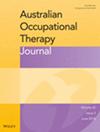Fidelity, acceptability, and feasibility of the revised functional autonomy measurement system for hospitalised people: An implementation study
Abstract
Introduction
The revised functional autonomy measurement system (SMAF-R) is an outcome measure of activity performance and resource needs. This study aimed to measure the implementability of the SMAF-R as a routine outcome measure in acute and subacute inpatients.
Methods
This was a mixed-methods implementation study. Occupational therapists were asked to complete the SMAF-R in hospitalised people with an anticipated length of stay greater than 48 hours over a 12-month period (n = 13,348). A baseline audit of SMAF-R completion rates was conducted, and behaviour change interventions were delivered over 12 months. The Implementability of Healthcare Interventions conceptual framework was used to evaluate fidelity (completion rates), acceptability (staff survey with quantitative and qualitative responses), and feasibility (change in SMAF-R scores from admission to discharge). Quantitative and qualitative (analysed thematically) data were integrated.
Consumer involvement
Occupational therapists and other staff working to improve outcome measure completion within the electronic medical record and other allied health teams were consulted when developing and delivering behaviour change interventions.
Findings
Peak completion of the SMAF-R did not meet an 80% fidelity success rate (admission: 32% in acute and 66% in subacute; discharge: 12% in acute and 48% in subacute). Two thirds of occupational therapists reported the SMAF-R was an acceptable measure to use, but only 38% liked using it. Thematic analysis revealed three themes: (1) A greater understanding of the relevance of the SMAF-R influenced acceptability; (2) using the SMAF-R within an electronic medical record may facilitate completion; and (3) it takes more time to complete SMAF. Patients made clinically significant improvements in SMAF-R scores during their hospital stay (median difference 16.5 [6.5–27.0], p < 0.001, n = 764).
Conclusion
Although most occupational therapists reported the SMAF-R was acceptable, there were mixed opinions regarding the relevance of the SMAF-R in this setting, which may have impacted fidelity. Additional prompting and training (especially regarding understanding SMAF-R relevance to practice) may assist with improving SMAF-R completion. Further research is required to assess the psychometric properties of the SMAF-R in the hospital environment.
PLAIN LANGUAGE SUMMARY
The revised functional autonomy measurement system (SMAF-R) is an assessment tool used to measure performance in everyday activities (such as showering) and the resources needed to complete these tasks (e.g., a shower chair or someone's help). Occupational therapists can use it at the start of a patient admission and again at the end in different hospital settings to assess patients' needs and see if they improve.
This study aimed to measure (1) how often occupational therapists use the SMAF-R with patients in hospital, (2) how acceptable occupational therapists find the SMAF-R, and (3) whether the SMAF-R shows changes in patients' abilities during their hospital stay. Before the study, usual completion of the SMAF-R was measured, and it was found to be completed in less than 1% of patients. Strategies were introduced to improve SMAF-R completion over 12 months. After this, completion of the SMAF-R improved to between 9% and 38% in different hospital settings. Changes in SMAF-R scores showed that patients improved during their time in hospital. Most occupational therapists reported the SMAF-R was an acceptable measure, but less than half liked using it. The low completion rates suggested that either the SMAF-R was not fit for purpose in this setting or that more support is needed to increase completion.

 求助内容:
求助内容: 应助结果提醒方式:
应助结果提醒方式:


